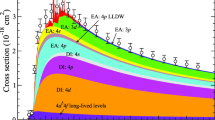Abstract.
We present in this paper a multi-reference coupled cluster (MRCC) formulation for energy differences which treats orbital relaxation and correlation effects on the same footing, by invoking a novel cluster ansatz of the valence portion of the wave operator Ωv. Unlike in the traditional normal-ordered exponential representation of Ωv, our new relaxation-inducing ansatz, represented symbolically as E r(S), allows contractions between the spectator lines and also certain other special contractions. By an extensive theoretical analysis, taking as an example the case of one-hole model space (the IP problem), we demonstrate that our ansatz incorporates in a manifestly spin-free form the orbital relaxation to all orders. The traditional Thouless-type of exponential transformation via one-body excitations can induce the same effect, as is done in the valence-specific or the quasi-valence-specific MRCC formalisms, but they have to be done in the spin-orbital basis – making the spin adaptation of the problem a complicated exercise. In contrast, we use a spin-free representation of the cluster operators right from start, but expand the rank of the cluster operators by involving spectator orbitals to distinguish the various spin possibilities. The combinatorial factors entering the contracted power series in E r(S) are chosen in such a way that they correspond to what we would have obtained if we had used a Thouless-like transformation to induce the orbital relaxation. Our working equations generally have only finite powers of the cluster operators S, resulting in a very compact formulation of the relaxation problem. Pilot numerical applications for the IP computations of HF and H2O in the core, the inner valence and the outer valence regions show very good performance of the method vis-a-vis those obtained using the traditional normal ordered ansatz for Ωv. The improvement in the core IP value is particularly impressive, although even for the valence regions there is an overall improvement of the IP values.
Similar content being viewed by others
Author information
Authors and Affiliations
Additional information
Received: 3 August 1998 / Accepted: 30 September 1998 / Published online: 15 February 1999
Rights and permissions
About this article
Cite this article
Jana, D., Bandyopadhyay, B. & Mukherjee, D. Development and applications of a relaxation-inducing cluster expansion theory for treating strong relaxation and differential correlation effects. Theor Chem Acc 102, 317–327 (1999). https://doi.org/10.1007/s002140050504
Issue Date:
DOI: https://doi.org/10.1007/s002140050504




